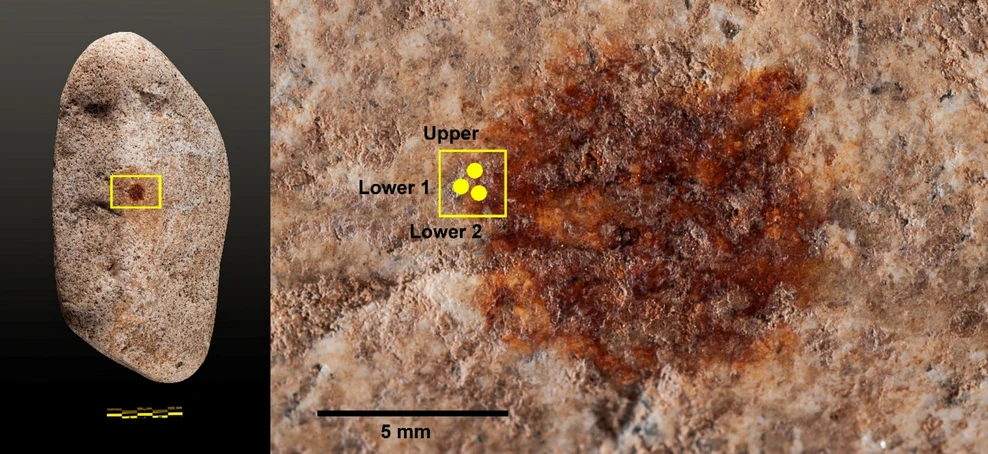A small pebble found in a rock shelter at San Lázaro, in central Spain, could revolutionize our understanding of prehistoric artistic expression. Marked with red pigment and featuring a partial human fingerprint, this intriguing object dates back approximately 50,000 years. It may represent the oldest known example of portable art in Europe, and possibly even in the world.
A Revealing Scientific Analysis
This seemingly ordinary rock fragment was uncovered in 2022 by a team of Spanish archaeologists beneath 1.5 meters of sediment. These geological layers are attributed to Neanderthal groups that inhabited the area during the Middle Paleolithic. This archaeological context suggests that the object was not a random finding but rather a result of intentional marking, likely carrying symbolic significance.
The true nature of the stone was revealed only after a thorough study. Multispectral imaging techniques and dermatoglyphic analysis (the study of fingerprints) enabled researchers to detect a deliberately applied patch of red ochre, along with a human imprint embedded in the pigment layer. Scientists believe this imprint may belong to a Neanderthal.
According to María de Andrés-Herrero, a professor at Complutense University of Madrid and co-author of the study, the pebble originated from the Eresma River, located more than five kilometers from the San Lázaro site, indicating that it was intentionally transported. This suggests that its shape, texture, or symbolic significance motivated its movement.
Neanderthal Art?
During a press conference, Gonzalo Santonja, head of Spanish heritage, described this discovery as potentially the oldest example of portable art in Europe. He emphasized that it could also be the only object of its kind attributed to Neanderthals, challenging traditional ideas about their cognitive abilities and creativity.
This finding contributes to a growing body of evidence suggesting that Neanderthals possessed advanced symbolic behaviors. The use of pigments and the presence of a fingerprint indicate a conscious act that could have had artistic, ritualistic, or communicative significance.
Traditionally viewed as primitive beings cognitively inferior to Homo sapiens, Neanderthals are revealing a much different side today. Previous evidence, such as cave paintings, shell ornaments, or funerary practices, had already demonstrated their ability to engage in complex symbolic behaviors. However, the San Lázaro pebble, with its embedded fingerprint in ochre, offers an intimate and tangible glimpse into their artistic expression.

A Renewed Vision of Neanderthals
The intentional application of pigments and the choice to leave an imprint suggest a self-awareness and a desire to mark their passage, both literally and metaphorically. This could represent a ritual, an artistic gesture, or a form of communication, dimensions that were once thought to be exclusive to our species. These actions reflect abstract thinking and symbolic capacity, previously considered unique to Homo sapiens.
This discovery not only enriches our understanding of Neanderthals but also raises broader questions about the origins of symbolic behavior in humans. Did these capabilities emerge independently in different species? Or did they exist within a cultural framework shared by coexisting human groups?
If Neanderthals were able to produce objects with significant symbolic weight, it suggests that human culture developed in a much richer and more diverse environment than previously believed. The story of humanity may thus be one of a mosaic of species sharing, to varying degrees, aesthetic and symbolic sensibilities.
The San Lázaro site is now a priority for archaeological excavations. Researchers hope to uncover more artifacts that can shed light on the cultural and cognitive life of Neanderthals. With modern technologies, such as 3D imaging and chemical analysis, further evidence of their creativity may emerge.
Moreover, for generations, Neanderthals engaged in a curious collection in this cave.
I’m a disabled, xennial Christ-follower, slightly off kilter (but aren’t all “ar-teeests”?).
Hope you enjoy my rantings, don’t take my sarcasm too seriously and know that comments are welcome. 🙂


Leave a Reply